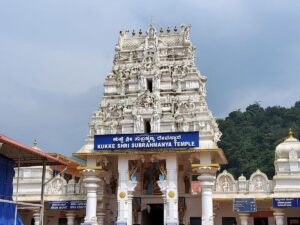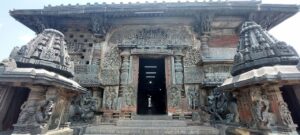Sri Kukke Subramanya Temple: Lord of Serpents
Sri Kukke Subramanya Temple is a Hindu temple located in the village Subramanya, of Kadaba taluk in Dakshina Kannada district, Karnataka, India. It is dedicated to Lord Subramanya, who is a form of Kartikeya, the Hindu god of war.
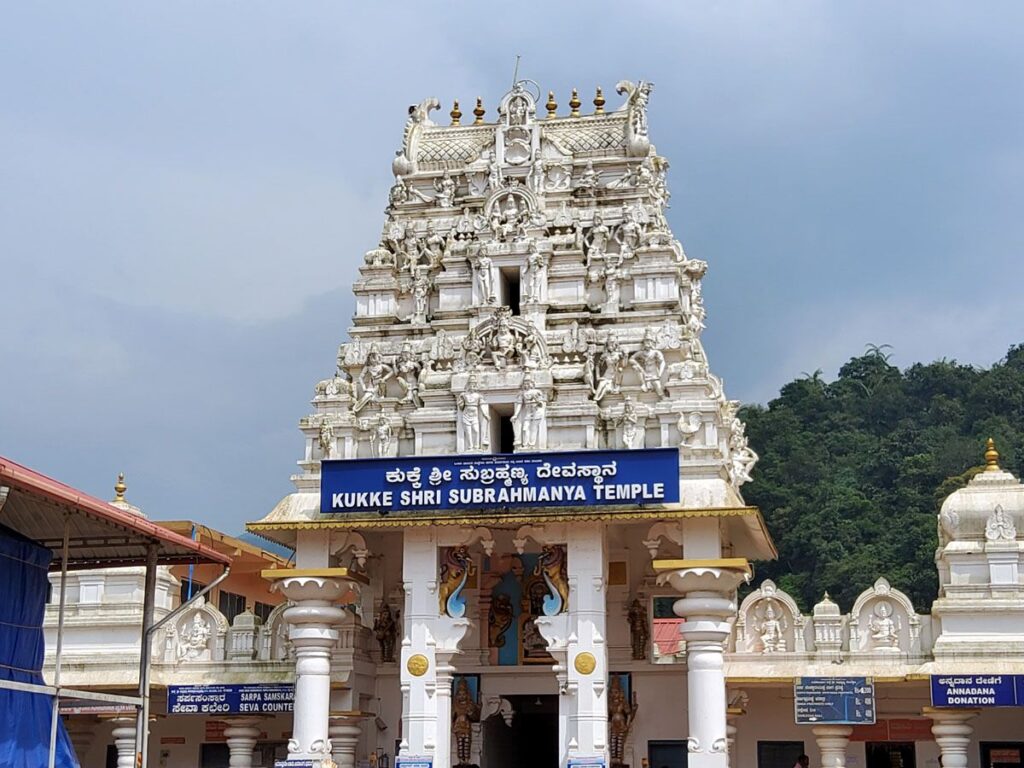
Contents
- 1 Sri Kukke Subramanya Temple History:
- 2 Legend of Sri Kukke Subramanya Temple:
- 3 Significance of Sri Kukke Subramanya Temple:
- 4 Myths & Beliefs of Sri Kukke Subramanya Temple:
- 5 Sri Kukke Subramanya Temple Timing & Rituals:
- 5.0.1 Udupi Sri Krishna Temple: Mathura of South India
- 5.0.2 Goravanahalli Mahalakshmi Temple
- 5.0.3 Sri Kukke Subramanya Temple: Lord of Serpents
- 5.0.4 Chennakesava Temple Belur: Finest Hoysala Architecture
- 5.0.5 Shishileshwara Temple: 700 yrs old Sacred Fishes
- 5.0.6 Nayakanahatti Thipperudra Swamy Temple
- 6 Places to visit near Sri Kukke Subramanya Temple:
- 7 FAQ:
- 8 How to reach Sri Kukke Subramanya Temple:
- 9 Google Maps:
Sri Kukke Subramanya Temple History:
Sri Kukke Subramanya Temple has a rich history and is steeped in mythology. According to one legend, after defeating the demon rulers Tarakasura and Shurapadmasura, Lord Subramanya reached Kumara Parvatha with his brother Ganesha. There, he was received by Indra, the king of gods, who offered his daughter Devasena in marriage to Subramanya. The divine wedding took place on Margashira shudha shashti at Kumara Parvatha, with blessings from Brahma, Vishnu, Rudra, and other deities.
Another legend associated with the temple is that the divine serpent Vasuki sought refuge here along with other serpents to escape from Garuda, the legendary bird and vehicle of Lord Vishnu. This is why Lord Subramanya is also worshipped as the lord of serpents at Kukke Subramanya. The temple is particularly known for its serpent appeasement rituals, believed to be beneficial for those seeking relief from Naga Dosha (curse of the serpent god).
Read More>> Shree Somnath Jyotirling Temple: The Shrine of Eternal Light
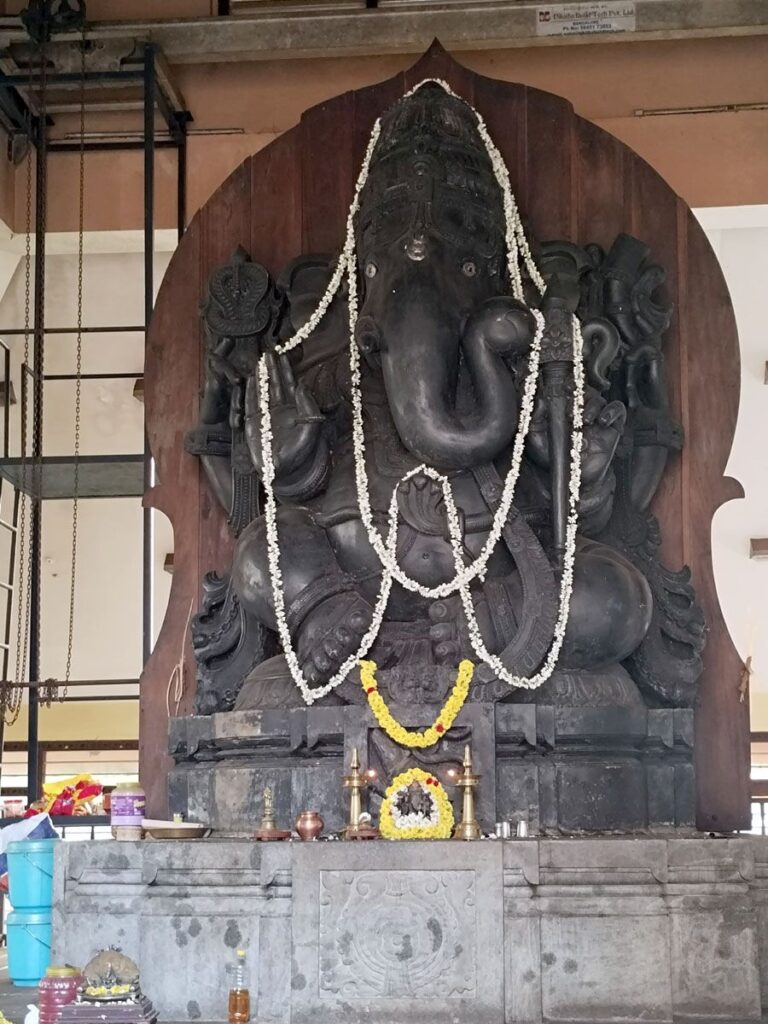
Legend of Sri Kukke Subramanya Temple:
Seeking Refuge: The epics narrate that the divine serpent Vasuki and other serpents sought refuge under Lord Subrahmanya when threatened by Garuda, the powerful bird-god vehicle of Lord Vishnu.
Abode of Nagas: Lord Subrahmanya granted them protection, and since then, Sri Kukke Subramanya Temple has been considered a sacred place for appeasing serpent deities or Nagas. Here, Subramanya is worshipped as a serpent himself, often depicted merged with the serpent king Vasuki.
Divine Marriage: The legend further adds that Lord Subrahmanya married Valli, the daughter of a tribal chief, on the banks of the Kumaradhara River, which flows near the temple.
Read More>> Tripura Sundari Temple in Tripura
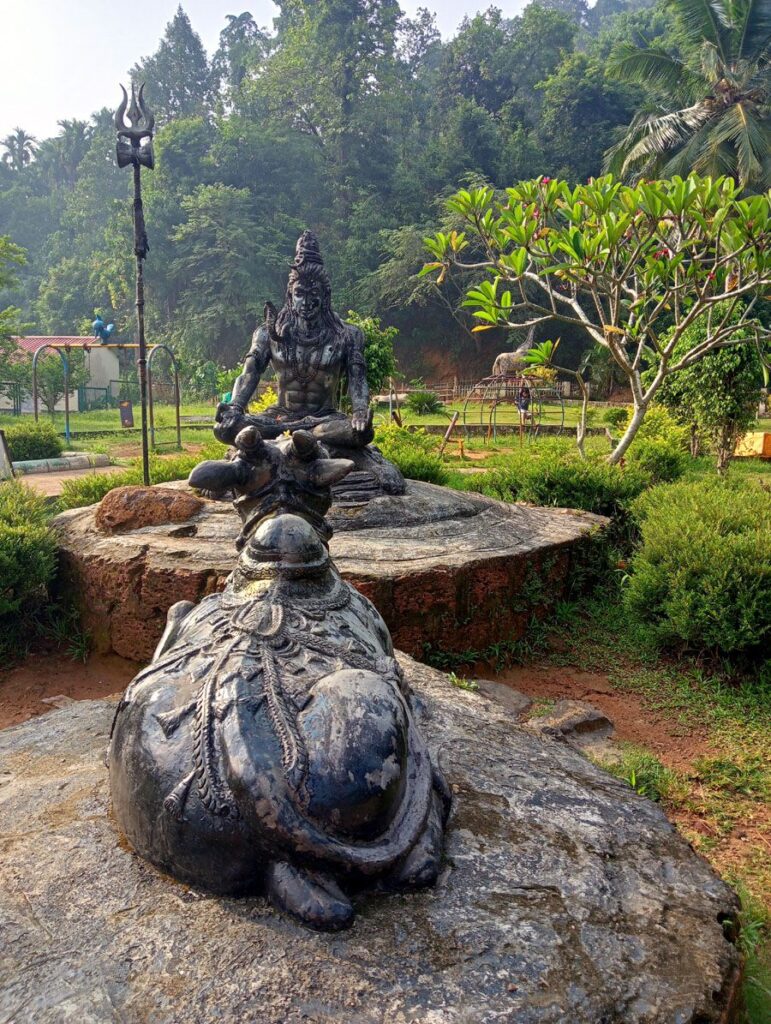
Significance of Sri Kukke Subramanya Temple:
Lord Subramanya and Serpents: It is dedicated to Lord Subramanya, also known as Kartikeya, who is worshipped as the lord of all serpents. Devotees believe that seeking blessings here offers relief from serpent-related afflictions and brings good fortune.
Ancient Origins: The temple is estimated to be 5,000 years old, and is considered one of the seven holy kshetras (pilgrimage sites) created by Saint Parashurama.
Location: Situated amidst the Western Ghats, the temple’s picturesque setting adds to its spiritual significance. The surrounding mountains, Kumara Parvatha and Shesha Parvatha, are seen as symbolic representations of Lord Subramanya and the serpent king, Vasuki.
Specific Pujas: The temple offers unique pujas (prayers) like Sarpa Samskara and Nagapratishta to appease the serpent deities and overcome doshas (astrological afflictions).
Read More>> Panch Kedar Yatra: Ultimate Travel Guide to 5 Divine Shiv Temples
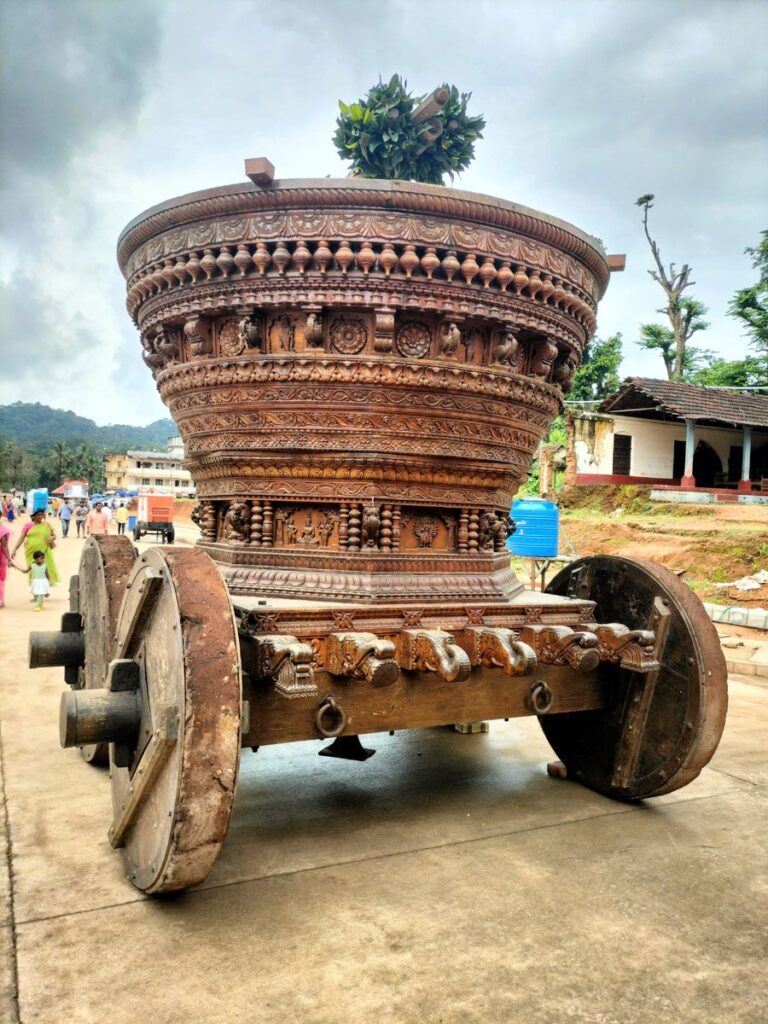
Myths & Beliefs of Sri Kukke Subramanya Temple:
Refuge for Serpents: One of the central beliefs is that the temple provided refuge to the divine serpent Vasuki and other serpents when they were threatened by Garuda, the bird-like vehicle of Lord Vishnu. This connection to serpents makes the temple a popular destination for those seeking remedies for snake bites or appeasing serpent spirits believed to be causing harm.
Lord Subramanya and Vasuki: A related myth narrates that Lord Subramanya subdued the serpent Vasuki and wore him as an ornament around his neck. This act of subduing is seen as a symbolic victory of good over evil.
Temple Traditions: The temple follows traditions laid out in the Tantra Sara Sangraha, a text attributed to Madhvacharya, a Hindu philosopher. Priests at the temple are Shivalli Madhwa Brahmins.
Festivals and Sevas: Several festivals and rituals are observed at the temple, including Shasti (especially significant), Sarpasamskara (performed for appeasement of serpent spirits), and Nag Panchami (dedicated to serpents).
Read More>> Shankaracharya Temple | Jyeshteshwara Temple
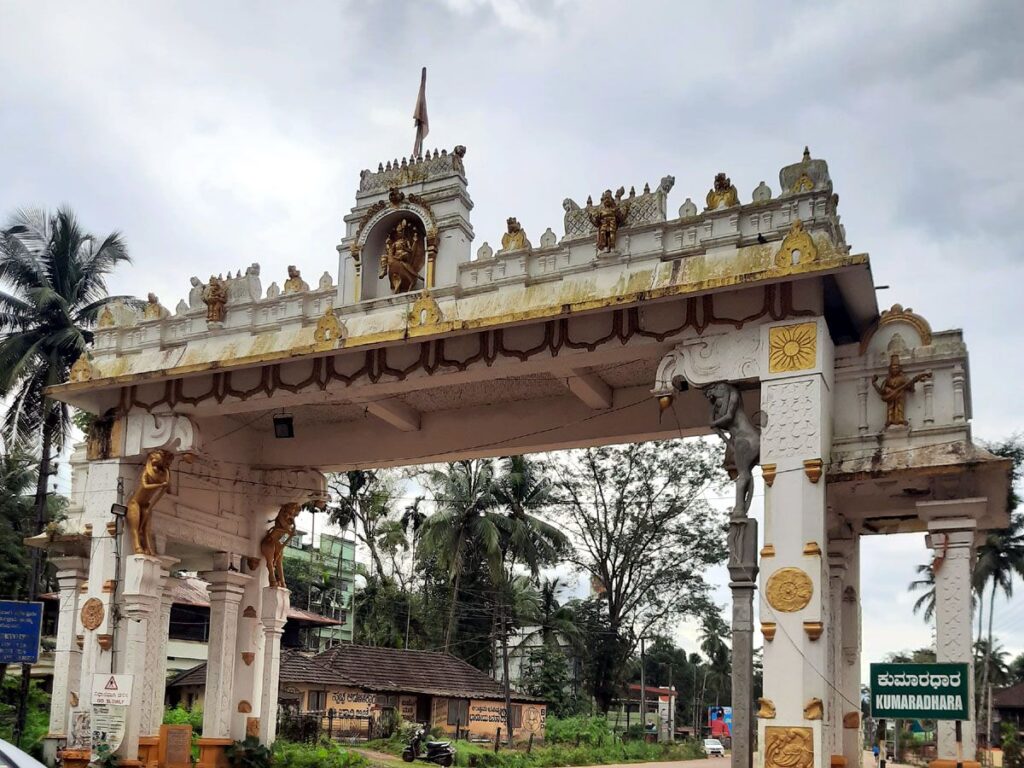
Sri Kukke Subramanya Temple Timing & Rituals:
Temple Timings:
- The temple doors open at 5:00 AM for Govu Pooja.
- Ushakala Pooja is performed between 5:30 AM and 6:00 AM.
- Devotees can perform sevas between 6:30 AM and 10:00 AM.
- Madhyanna Pooja (including Kalashapooja, Panchamrutha Abhisheka, Archana, Mahanaivedya, and Mahamangalarathi) is performed between 10:00 AM and 12:15 PM.
- Theertha Prasada distribution takes place between 12:30 PM and 1:30 PM.
- Anna Santharpane (lunch) is served between 11:30 AM and 2:00 PM.
- Hannukai Seva and Mangalarathi by devotees happen between 3:30 PM and 6:00 PM.
- Nisha Pooja and Mahamangalarathi are performed between 6:00 PM and 7:45 PM.
- Theertha Prasada distribution and closing of the main doors happen between 7:45 PM and 8:30 PM.
- Anna Santharpane (dinner) is served between 7:30 PM and 9:30 PM.
Please note that these timings are general and may vary on special occasions.
Rituals:
There are many rituals performed at the Sri Kukke Subramanya Temple, including:
- Ashlesha Bali Pooja: This is an important puja performed for Sarpa Dosha or Kal Sarpa Dosha. The pooja takes place in two shifts; one at 7:00 AM and one at 9:15 AM.
- Sarpa Samskara Pooja: This pooja is performed for two days and is believed to be beneficial for those seeking relief from chronic skin diseases and various other problems.
Places to visit near Sri Kukke Subramanya Temple:
- Kumaradhara River: The temple is situated on the banks of the Kumaradhara River, which provides a serene environment for visitors to relax and enjoy the natural surroundings.
- Kukke Shree Abhaya Mahaganapathi Temple: This temple dedicated to Lord Ganesha is located close to the Sri Kukke Subramanya Temple and is worth a visit for its architectural beauty and spiritual significance.
- Adi Subrahmanya Temple: Situated about 8 kilometers from Sri Kukke Subramanya Temple, this ancient temple dedicated to Lord Subrahmanya is believed to be the original location where Lord Subrahmanya killed the demon Tharakasura.
- Bisle Ghat Viewpoint: Located about 35 kilometers from Subramanya, Bisle Ghat offers breathtaking panoramic views of the Western Ghats and is a popular spot for nature lovers and photographers.
- Jenukal Gudda: Also known as the Honey Stone Hill, Jenukal Gudda is a picturesque hill located around 40 kilometers from Subramanya. It offers trekking opportunities and stunning views of the surrounding landscapes.
- Kumar Parvatha Trek: For adventure enthusiasts, Kumar Parvatha trek, starting from the Kukke Subramanya Temple, offers an exhilarating experience with beautiful vistas and lush greenery along the trail.
- Sakleshpur: Located around 70 kilometers from Subramanya, Sakleshpur is a charming hill station known for its coffee plantations, waterfalls, and lush green hills. It’s a perfect destination for a day trip or a weekend getaway.
FAQ:
General:
- What is the significance of the temple? The temple is dedicated to Lord Subramanya, believed to be the protector from snakebites, evil forces, and diseases. It’s particularly known for rituals related to Sarpa Dosha (snake curse) appeasement.
- Where is the temple located? The temple is situated in Subrahmanya village, Dakshina Kannada district, Karnataka, India.
Temple Visit:
- What are the visiting hours? Timings are generally from 5:00 AM to 8:30 PM, with poojas and rituals happening throughout the day. Exact times may vary, so it’s best to check the official website or call the temple administration for the latest information.
- Is there a dress code? There’s no strict code, but modest clothing is recommended. Men should ideally wear dhotis/pants and shirts, while women can wear sarees or salwar kameez.
- What are some things to avoid while visiting? You should not enter without bathing beforehand. Avoid wearing shirts, coats, caps, or items made of animal skin inside the temple. Mobile phones, tobacco products, and chewing gum are also prohibited.
Rituals:
- What are the important rituals performed here? A popular ritual is Ashlesha Bali Pooja for relieving Sarpa Dosha. Another is Sarpa Samskara Pooja, believed to be beneficial for chronic skin diseases and other problems.
- How do I book a pooja? It’s advisable to contact the temple administration directly for booking specific pujas.
Additional Information:
- Does the temple offer any facilities for devotees? Yes, the temple provides free cloakrooms for luggage, annadaana (free meals) facility, and electric buggies for elderly or disabled devotees.
How to reach Sri Kukke Subramanya Temple:
- By Air: The nearest airport to Sri Kukke Subramanya Temple is Mangalore International Airport, which is approximately 115 kilometers away. From the airport, you can hire a taxi or take a bus to reach the temple.
- By Train: The nearest railway station to Sri Kukke Subramanya Temple is Subramanya Road Railway Station, which is around 7 kilometers away. However, this station is a small one and may not be well-connected to major cities. Alternatively, you can take a train to Mangalore Junction Railway Station or Hassan Railway Station, both of which are well-connected to major cities in India. From Mangalore or Hassan, you can hire a taxi or take a bus to reach the temple.
- By Road: Sri Kukke Subramanya Temple is well-connected by road. You can reach the temple by bus, taxi, or private vehicle. The temple is approximately 105 kilometers from Mangalore and 260 kilometers from Bangalore. If you’re traveling from Bangalore, you can take NH75 via Hassan and Sakleshpur to reach the temple. From Mangalore, you can take NH75 via Puttur and Sullia to reach the temple.
- By Bus: Karnataka State Road Transport Corporation (KSRTC) operates regular bus services to Subramanya from major cities and towns in Karnataka. You can also find private buses and tourist cabs plying on this route.



